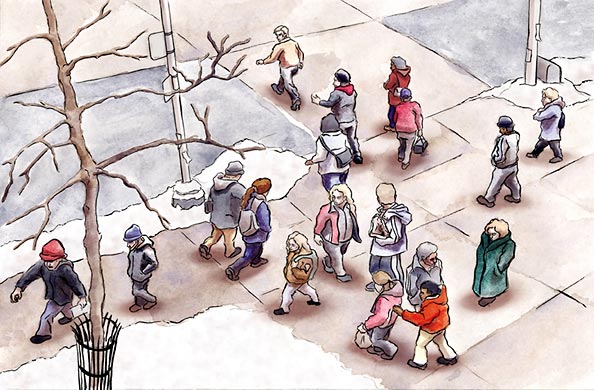walking for the brain : : : : : : : Lately I have been paying attention to what goes on in my mind as I walk the streets of the city. What triggered my curiosity is that a recognizable pattern seems to be emerging in my thought process as I journey on foot to my daily destinations. I leave my apartment (run out the door would be more exact), my head filled to capacity with thoughts that have been gathering force since I woke up. A jumble of fragmented ideas: work-related problems, relationship dilemmas, and to-do lists, all intersecting at a hundred different angles, ping-ponged through a seemingly unstoppable flow of analogies, word pairings and flashbacks. But shortly after I set out on my walk, the clamor starts to subside as I take in my surroundings. Forced to focus on where I am going, I stop juggling my competing thoughts and let them all fall down. Most of them just roll away and disappear. The health benefits of walking, and exercise generally, are varied: they range from reducing one’s level of cholesterol and risks of diabetes to improving balance, depth perception and foot-eye coordination. Exercising also helps alleviate depression and increases the release of endorphins. But a study conducted at the Harvard Medical School (reported in Harvard’s Men’s Health Watch in April 2003) suggests that walking could improve cognitive function and memory as well. And researchers at the University of Illinois found that a brisk walk can actually enhance one’s judgment. As we venture out to bathe in the world with little more in the way of protection than the clothes on our backs and whatever streetsmarts we have managed to build up over time, our senses have to be on high alert in order for us to successfully negotiate the physical realities at hand: other pedestrians, street furniture, cars, the occasional puddle of vomit. A balance is struck between the private wanderings of our thoughts and the physical world and, as the disconnect between the two spaces is never complete, our thoughts are informed by what our senses take in. As a result of our heightened perception, the cast of mind we bring to the street – manifest in our inner thoughts – intersects with the events unfolding there, sometimes giving rise to powerful and lasting images. Not all of us possess the lyrical inventiveness of Joseph Cornell or the voraciousness of Walter Benjamin, but the streets provided both of these dedicated walkers ample materials for inspiration. Many of Cornell’s fragmented yet photographic memories of his day-long outings found their way, sometimes after a slow process of distillation, into his masterfully arranged glassed boxes. And Benjamin’s Arcades Project seems to have come from an all-encompassing desire to catalogue, in the form of hundreds of entries grouped by topic, the essence of Nineteenth Century Paris. Whatever the explanation behind these vivid impressions, one thing seems clear: given the right state of alertness, a stranger’s face glanced for a brief moment in a crowd, two lines of dialogue overheard in a park, or even a subtle movement detected out of the corner of one’s eye through a glass window, can somehow solidify into rock-hard memories that have the potency of icons and the staying-power of a catchy tune, to be recalled later on over and over, at the drop of a mnemonic hat. |
spacing.ca || contact || subscribe || in this issue || stores (c) 2004 Spacing Publishing |

